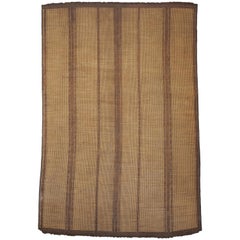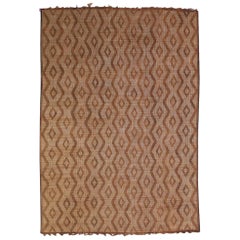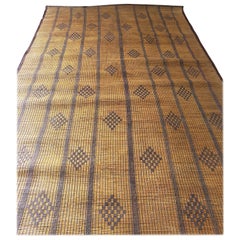Mauritanian Sahara Mats
Vintage 1950s Mauritanian Mid-Century Modern Moroccan and North African ...
Leather, Palmwood
Recent Sales
Vintage 1970s Sahrawi Mid-Century Modern Moroccan and North African Rugs
Leather, Palmwood
Vintage 1950s Mauritanian Mid-Century Modern Moroccan and North African ...
Leather, Palmwood
Vintage 1950s Mauritanian Mid-Century Modern Moroccan and North African ...
Leather, Palmwood
Vintage 1950s Mauritanian Mid-Century Modern Moroccan and North African ...
Leather, Palmwood
Vintage 1950s Mauritanian Mid-Century Modern Moroccan and North African ...
Leather, Palmwood
People Also Browsed
Vintage 1960s Swedish Scandinavian Modern Armchairs
Leather, Rattan
Vintage 1950s Italian Mid-Century Modern Shelves
Bamboo, Rattan
Vintage 1930s Italian Mid-Century Modern Chairs
Velvet, Wood
Vintage 1960s Italian Modern Vases
Murano Glass
Antique 18th Century Japanese Edo Paintings and Screens
Brass
Vintage 1950s Italian Mid-Century Modern Dining Room Chairs
Velvet, Glass, Wood
Antique 1860s Swedish Victorian Sideboards
Wood
Mid-20th Century Italian Mid-Century Modern Sofas
Metal
Vintage 1970s Italian Space Age Sectional Sofas
Cotton, Velvet, Foam, Linen
21st Century and Contemporary French Mid-Century Modern Floor Mirrors an...
Rattan
Vintage 1970s Brazilian Post-Modern Chairs
Hardwood
Mid-20th Century Burmese Coffee and Cocktail Tables
Wood
2010s French Mid-Century Modern Coffee and Cocktail Tables
Walnut
Early 20th Century Persian Mid-Century Modern Persian Rugs
Wool
2010s Italian Mid-Century Modern Desks and Writing Tables
Metal
Late 20th Century Moroccan Tribal Moroccan and North African Rugs
Wool
Mauritanian Sahara Mats For Sale on 1stDibs
How Much are Mauritanian Sahara Mats?
A Close Look at Mid-century-modern Furniture
Organically shaped, clean-lined and elegantly simple are three terms that well describe vintage mid-century modern furniture. The style, which emerged primarily in the years following World War II, is characterized by pieces that were conceived and made in an energetic, optimistic spirit by creators who believed that good design was an essential part of good living.
ORIGINS OF MID-CENTURY MODERN FURNITURE DESIGN
- Emerged during the mid-20th century
- Informed by European modernism, Bauhaus, International style, Scandinavian modernism and Frank Lloyd Wright’s architecture
- A heyday of innovation in postwar America
- Experimentation with new ideas, new materials and new forms flourished in Scandinavia, Italy, the former Czechoslovakia and elsewhere in Europe
CHARACTERISTICS OF MID-CENTURY MODERN FURNITURE DESIGN
- Simplicity, organic forms, clean lines
- A blend of neutral and bold Pop art colors
- Use of natural and man-made materials — alluring woods such as teak, rosewood and oak; steel, fiberglass and molded plywood
- Light-filled spaces with colorful upholstery
- Glass walls and an emphasis on the outdoors
- Promotion of functionality
MID-CENTURY MODERN FURNITURE DESIGNERS TO KNOW
- Charles and Ray Eames
- Eero Saarinen
- Milo Baughman
- Florence Knoll
- Harry Bertoia
- Isamu Noguchi
- George Nelson
- Danish modernists Hans Wegner and Arne Jacobsen, whose emphasis on natural materials and craftsmanship influenced American designers and vice versa
ICONIC MID-CENTURY MODERN FURNITURE DESIGNS
- Eames lounge chair
- Nelson daybed
- Florence Knoll sofa
- Egg chair
- Womb chair
- Noguchi coffee table
- Barcelona chair
VINTAGE MID-CENTURY MODERN FURNITURE ON 1STDIBS
The mid-century modern era saw leagues of postwar American architects and designers animated by new ideas and new technology. The lean, functionalist International-style architecture of Le Corbusier and Bauhaus eminences Ludwig Mies van der Rohe and Walter Gropius had been promoted in the United States during the 1930s by Philip Johnson and others. New building techniques, such as “post-and-beam” construction, allowed the International-style schemes to be realized on a small scale in open-plan houses with long walls of glass.
Materials developed for wartime use became available for domestic goods and were incorporated into mid-century modern furniture designs. Charles and Ray Eames and Eero Saarinen, who had experimented extensively with molded plywood, eagerly embraced fiberglass for pieces such as the La Chaise and the Womb chair, respectively.
Architect, writer and designer George Nelson created with his team shades for the Bubble lamp using a new translucent polymer skin and, as design director at Herman Miller, recruited the Eameses, Alexander Girard and others for projects at the legendary Michigan furniture manufacturer.
Harry Bertoia and Isamu Noguchi devised chairs and tables built of wire mesh and wire struts. Materials were repurposed too: The Danish-born designer Jens Risom created a line of chairs using surplus parachute straps for webbed seats and backrests.
The Risom lounge chair was among the first pieces of furniture commissioned and produced by celebrated manufacturer Knoll, a chief influencer in the rise of modern design in the United States, thanks to the work of Florence Knoll, the pioneering architect and designer who made the firm a leader in its field. The seating that Knoll created for office spaces — as well as pieces designed by Florence initially for commercial clients — soon became desirable for the home.
As the demand for casual, uncluttered furnishings grew, more mid-century furniture designers caught the spirit.
Classically oriented creators such as Edward Wormley, house designer for Dunbar Inc., offered such pieces as the sinuous Listen to Me chaise; the British expatriate T.H. Robsjohn-Gibbings switched gears, creating items such as the tiered, biomorphic Mesa table. There were Young Turks such as Paul McCobb, who designed holistic groups of sleek, blond wood furniture, and Milo Baughman, who espoused a West Coast aesthetic in minimalist teak dining tables and lushly upholstered chairs and sofas with angular steel frames.
Generations turn over, and mid-century modern remains arguably the most popular style going. As the collection of vintage mid-century modern chairs, dressers, coffee tables and other furniture for the living room, dining room, bedroom and elsewhere on 1stDibs demonstrates, this period saw one of the most delightful and dramatic flowerings of creativity in design history.
Finding the Right Moroccan-rugs for You
Antique and vintage Moroccan rugs serve as an exceptional piece of decor. Whether it’s to tie your bedroom together or to add a dazzling array of colors and graphically provocative shapes and other elements to your living room wall, there’s increased demand for all types of Moroccan tribal rugs, especially as bohemian, global and eco styles are on the rise and because tapestries and wall hangings are definitely cool again.
Travelers and interior design lovers from all over the world are big fans of the complex geometric patterns and bold color palettes that we typically associate with rustic, natural Moroccan and North African rugs.
In the West, the current infatuation with handwoven vintage Moroccan tribal rugs stretches to the mid-20th century. Then, designers such as Alvar Aalto, Frank Lloyd Wright and Le Corbusier offset austere interiors with vibrant and alluring mid-century modern Moroccan rugs. (Le Corbusier integrated these rugs in his designs for Villa La Roche in Paris, while Frank Lloyd Wright’s Fallingwater in Pennsylvania is also home to distinctive Moroccan floor coverings.)
Moroccan rugs date back to the Paleolithic era, when Berber tribes, which comprised many different members of an ethnic group native to North Africa, would weave these textiles with intricate images and symbols. Traditionally, Moroccan tribal weavings were made exclusively by women and solely for personal use. Dense pile rugs served not only as floor coverings but as mattresses, seating and even blankets in the winter months.
The Moroccan rug hasn’t survived this long merely because of its usefulness. These stunning works take at least two to three weeks to weave, and each woman weaves the story of her life into the design. They are filled with symbolism and vary greatly depending on the locale where they were woven. In this way, part of the profound beauty of traditional Moroccan rugs lies in their historical and cultural significance.
One of the most widely loved styles of Moroccan rugs comes from the Beni Ourain tribes, a network of nearly two dozen individual tribes in the mountainous Middle Atlas region.
Vintage Beni Ourain rugs are woven from undyed, natural wool. The textures, imperfections and asymmetrical lines, which can’t be reproduced with mass production methods, as well as the neutral tones and understated geometry have endeared interior designers to these works for ages. In comparison to the spare Beni Ourain rugs, a more heavily decorated, widely colorful option can be found in Azilal Moroccan rugs, which contrast wonderfully with the rich, dark wood tones and clean lines that characterize mid-century modern furniture.
The collection of antique and vintage rugs and carpets on 1stDibs features a wide range of extraordinary Moroccan and North African rugs including Beni Ourain rugs, Azilal rugs, kilims and more.


